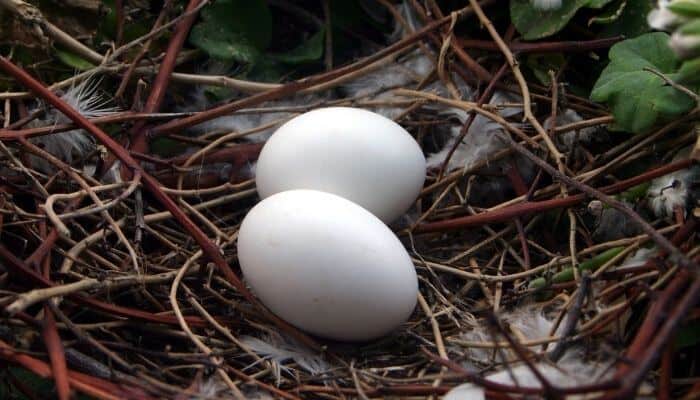Yes you can eat pigeon eggs.
Like any other eggs, they can be fried, poached or boiled.
Their yolk contains a lot of protein, plus carbohydrates and fat.
The problem is you need many of them to make a decent meal, as they are so small.
In some cultures pigeon eggs are regarded as delicacies.
Pigeon Egg Appearance
A pigeon’s egg measures about 3cm which is slightly smaller than a quail’s egg (3.5 cm) and much smaller than a hen’s egg (up to 6cm).

The egg has a porcelain-like surface and is smooth to the touch. Inside, the egg white has a slightly translucent appearance with a pale-yellowish yolk.
It has a stronger “eggy” aroma than other types of eggs.
Pigeon Egg Scarcity
Pigeon eggs attract a premium because they are rarer than other bird eggs – female pigeons only lay one to three eggs a fortnight compared to a hen’s (on average) daily output.
There is also another factor – pigeon intelligence!
Pigeons know exactly how many eggs they have laid which means if a keeper picks any of them, they need to be replaced with fake eggs.

Pigeons who lose their eggs are known to become depressed and overwhelmed and often won’t lay again.
It is also illegal in many countries to buy and sell fertilized eggs, adding further to the rarity factor.
Also Read:
How Long Do Pigeon Eggs Take To Hatch?
Do Pigeons Eat Other Birds Eggs?
Eating City vs Woodland Pigeon Eggs
There is some debate about whether the eggs of city-dwelling pigeons are healthy to eat, compared to their country cousins.
It is a question of diet. As opportunists and scavengers, feral town pigeons will eat almost anything they can get.

Because of that reason, they are considered to be exposed to all kinds of toxic chemicals and bacteria.
They can get infected or imbibe substances that can later be harmful to humans if either the eggs or the flesh is eaten.
The woodland pigeon, on the other hand, lives in a more natural habitat and eats healthier types of food so their eggs are therefore a healthy choice.
Commercial Pigeon Farming
Commercial pigeon farming survived into the 19th century.
People still do raise pigeons for this purpose, but on a much smaller scale.
This kind of pigeon production is mainly to supply restaurants that have more exotic menus.

It isn’t often that you find pigeons on the menu, either eggs or meat.
Whether or not they were raised for the pot or hunted as wild birds, you will probably never know.
Pigeon dishes tend to be on the menu of fine dining restaurants and maybe country gastropubs, but not a staple of regular/high street restaurants.
Pigeons As Cuisine
Since Roman times, recipes for pigeons have been recorded.
The young birds, the fledglings or squabs were mainly used because of the tenderness of their flesh.
Game pies have been around since medieval times.
These included various wild and hunted game such as venison, rabbit, pheasant and of course, pigeon.
Pigeon meat can be stewed, baked in pies or casseroles and roasted.
Eating Pigeon Eggs Today
Today pigeon is very rarely on the menu, neither the eggs nor the meat. It is one of our eating customs that has gone out of fashion with a mainly urbanized population.
Eating habits have changed and there are much more viable animals to farm. Commercially, raising pigeons for the market isn’t that profitable.
Although, those that live in rural areas may still have the occasional pigeon meal.
Pigeon eggs are more readily available in Southeast Asia.
In China, the pigeon egg is known as “animal ginseng” because its nutrients are able to remove toxins and fortify the kidneys.
Traditional Chinese medicine also attributes the encouragement of energy flow and improvement in skin condition – they are recommended to women, especially.
Handle Eggs Carefully
Pigeon eggs should be handled very gently because the shell is as thin as a sheet of paper and is very crispy.
The fact that transportation is difficult and rarely achieved without breakages is one of the reasons pigeon eggs are not commercially attractive.
And also on the handling side, even the boiling process can damage the shell and break it.
How to Eat Pigeon Eggs
Pretty much whatever you can do with an egg (hen, goose, and duck are the most common – although hens’ eggs are the clear favourite), you can do with a pigeon’s egg.
They are rarely used in baking as you would need 3-4 pigeon eggs for the equivalent of a hen’s egg.
Most chefs who use them regularly have the opinion that the best way to eat them is whole.
They might be boiled or steamed.
A popular method is to cook them by steaming then coating them in breadcrumbs and deep-frying them.
